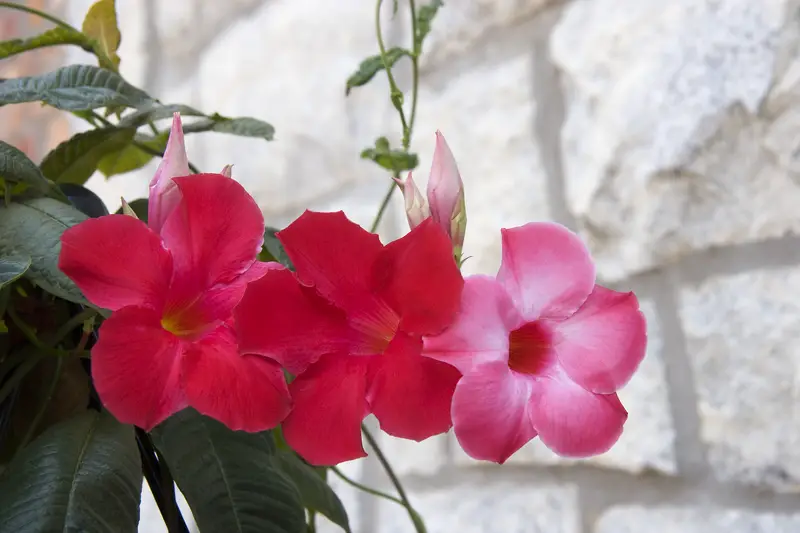Introduction
Mandevilla plants are like one of the most well-behaved vines you can find. Give it some support, and it’ll stay in its place without strangling other plants.
But that doesn’t mean you don’t take care of it. Like every other flower plant, this one, too, will want your attention. Even though it’s not a heavy feeder, a continuous flow of plant food is a must.
The best fertilizer for Mandevilla will provide all the necessary supplements while giving it the extra boost for flower production. In this comprehensive guide, I’ll talk about 5 of the top-graded fertilizers perfect for Mandevilla plants.
So, without further delay, let’s see what we have in store-

As an Amazon Associate, I earn from qualifying purchases.
Comparison of Our 5 Best Fertilizer for Mandevilla
1. Osmocote 277860 Smart-Release Plant Food Flower & Vegetable
Leading the pack with its smart-release plant food is the Osmocote 277860. This granular plant food has a special coating made of semi-permeable resin.
After you apply the fertilizer, it nourishes the plant for up to 4 months. As it’s a slow-release fertilizer, it takes its time to release the nutrients into the soil.
However, it’s not that simple. You see, the coating of this fertilizer allows water to penetrate. As you water down regularly, the granules start breaking efficiently.
To make these things even better, the granules act according to the temperature. For instance, it’ll release more nutrients when it’s summer or during the growing season. When the plant is in its dormant stage, it restricts that nutrients. Seems handy, right?
For providing vigorous growth and healthy roots, this fertilizer is a top contender.
2. Nelson Plant Food For All Flowering Vines
Next up, we have the Nelson Plant Food, the complete flowering solution for Mandevilla vines. Like every other flower plant, Mandevilla too needs extra nutrients for thriving bloom.
Long story short, you’ll have to feed extra phosphorus to increase flower production. This fertilizer will give your plants the extra boost it needs. In addition to boosting flower production, it strengthens the woody vines.
Other than that, it comes with 4 types of nitrogen for promoting the roots’ robust growth. The Epsom salt and low salt potassium also play a significant role in the blooming department.
However, there’s one problem. My suggestion would be to keep this fertilizer as a sidekick. When the flowering starts, that’s where this should come in.
Mandevilla plants need balanced fertilizer throughout the season. So, you shouldn’t use a fertilizer that focuses on blooming all year long. Nonetheless, if it were up to me, I’d keep it in my stock and use it whenever necessary.
3. BioAdvanced 701110A All in One Rose and Flower Care Granules
The BioAdvanced 701110A has always been one of my favorite fertilizers for flower plants for its 3 in 1 formula. It goes without saying that flower plants have always been best-loved by insects. Unfortunately, insects mean diseases.
So, BioAdvanced thought of making a complete solution for 3 problems. First of all, it’ll nourish your plants with its unique 6-9-6 formula. It’ll feed nutrients for encouraging proper growth and healthy roots.
Second, it’ll keep out all the insects. From Japanese beetles to other aphids, nothing will come near your plants.
Even if some bacteria or virus attacks your plants, this fertilizer’s disease control properties are there to take care of it.
If we’re talking about uniqueness, this one sure stands out. This is the only fertilizer with 3 types of features, making it a complete package.
4. Scotts Super Bloom Water Soluble Plant Food
I’ve reviewed some excellent fertilizer till now. But one type of fertilizer was still missing from the lot. As you might’ve guessed already, it’s water-soluble or liquid fertilizers.
As most people have limited space, they’re slowly moving towards containers and pots. I’m not saying you can’t use other fertilizers than liquid ones for containers, but there’s a reason behind this.
Containers are small in size, so there’s a high risk that the fertilizer will cause burns to the roots. With a liquid fertilizer, that problem goes away as the concentration is low.
The Scotts Super Bloom Water Soluble Plant Food is the perfect choice for flowering plants such as Mandevilla. The 12-55-6 formula is mostly focused on ensuring vigorous growth and blooms.
I’d suggest you check out the product yourself to figure out more. At the end of the day, you should know what you’re getting, right?
5. Jobe’s Organics 555813 Flowering Liquid
Now, let’s talk about the final contender on this list, the Jobe’s Organics 555813 Flowering Liquid. If you look at the other liquid fertilizer on this list, you’ll notice that none of them are really balanced fertilizers.
I’m not saying those are bad, but when the plant’s not blooming, there’s no point in using high phosphorus-based fertilizers. Sometimes that can do more harm than good.
That’s why I thought of this product. While it won’t give you crazy blooms like the Scotts Super Bloom, it’s a fantastic choice for regular usage. It’ll give your Mandevilla vines enough nutrients to get stronger for the blooming season.
When the blooming gets here, you can switch to another one. So, that was my opinion on this fertilizer.
The A-Z Fertilizing Guide for Mandevilla
Mandevilla plants are famous for their evergreen and colorful flowers. But it’s not an easy job to take care of them. Apart from perfect soil conditions, you need to supply them with proper nutrients.
That’s the main reason behind this guide. I’ll come up with several factors considering Mandevilla fertilization. Anyone who follows these factors accordingly can expect lush flowers on Mandevilla all year long.
What Type of Fertilizer to Go for?
Mandevilla plants respond well to balanced fertilizers. These balanced fertilizers ensure the growth of the plant while maintaining adequate bloom.
My suggestion would be to go for a 20-20-20 fertilizer. With a balanced fertilizer like this, the plant should do quite well. However, the story’s not over yet.
You need to extra if you want flowers blooming all over the plant. A good option is to add high phosphorus regularly. When the flowering season starts, apply phosphorus food every 2-3 weeks.
That’s why you could also choose a fertilizer with a higher phosphorus ratio. But when applying fertilizers, it’s easy to go overboard. Overdosing on this can result in burns.
The safe way is to look at the N-P-K ratio and choose a balanced fertilizer. It’s not like you have to select a 20-20-20 fertilizer. A 14-14-14 or 6-9-6 fertilizer is also good enough.
Nonetheless, when the flowering season gets here, switch to a high phosphorus fertilizer. If the plant is in good condition, that extra phosphorus will boost the flower production.
When to Use the Fertilizer?
The growing season for Mandevilla is summer and spring. That’s when the plant needs nutrients the most. In that time period, make sure you put fertilizers every 2 weeks.
Like most plants, Mandevilla vines also stay dormant in winter. So, whatever you do, make sure you don’t fertilize your plants during that time.
In fact, you should stop fertilizing in the middle of fall. That’s when the wind starts getting colder. Even though you’ll see some growth if you use fertilizers in winter. But as the plant will stay in its dormant stage, it won’t be able to support the growth.
Another critical factor is the introduction to the outdoors. Let me break down a bit-
Many people keep their plants indoors when winter’s here. But the problem appears when winter’s gone, and you have to put it back in its old place.
As soon as people take it outside, they start putting fertilizers. That’s precisely what you shouldn’t do.
You see, the plant stayed indoors for a long time. So, give it some time to get accustomed with everything. After a week or two, then you start the basic fertilizing routine.
Other than that, it’s not a good idea to take the plant outside when there’s still frost. The perfect would be around April. You could also do it in March if you live in a warm climate. But don’t even think of taking it outside until May if you live in a snowy area.
Nonetheless, you should fertilize again in May. For younger plants, try to provide them with extra nitrogen.
As the plant gets older, the need for nitrogen also decreases. So, put out fertilizers every 2 weeks for proper growth to ensure lush colors and beautiful flowers.
Although there’s one common rule, if the plant’s in a container, the ideal choice would be to use a liquid fertilizer. For ground plants, go for a slow-release fertilizer.
Use those one a month and you’ll be all set. But whatever fertilizer you use, make sure to water it down so that it doesn’t burn the plant.
How to Use the Fertilizer?
As you’ve already figured out, you need 2 kinds of fertilizers for Mandevilla plants. One is for the overall growth of plants and the other one is for flower production.
Long story short; don’t use both fertilizers at the same time. Try to use these sparingly. Take 6-7 drops or 1 tbsp of fertilizer and mix it with a gallon of water.
Instead of regular water, use that fertilizer filled water on your plants. After another week has passed, continue with the phosphorus fertilizer.
However, the quantity and strength is a bit different depending on the lighting condition. Plants that stay in direct sunlight for a long time need extra strength in the fertilizer. So, use a bit more for those plants. The quantity and strength get half for plants grown in shade.
Nonetheless, never forget to moisten the soil around the plant. Doing this helps to limit root burns and salt buildups. Other than that, don’t spray fertilizer on the leaves and stems.
What Problem Can You Face While Fertilizing?
Just because something is good for you doesn’t mean you have to overindulge in that. Overdoing something is never good. The same goes for fertilizers.
For example, when you overdose on Mandevilla plants, you notice symptoms like leaf drops, stunted growth, and when the symptoms get, the foliage starts burning.
Whenever you see these symptoms, start flushing away excess nutrients with water. After 5 to 10 of watering, most of it should be gone.
After that, take care of the damaged part of the plant. Cut it away and don’t put it near other plants. It should come around in a short time with proper care.
Verdict
It can be easy to go overboard with fertilizers. Sometimes we even do it by mistake. But make sure you keep an eye out for overdosing, and it won’t happen. Nonetheless, I hope you could find the best fertilizer for Mandevilla though this guide. If you’ve got any other queries regarding this matter, contact us, and we’ll see what we can do for you.
